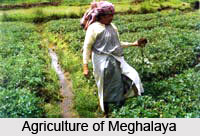Ten percent of the total area of Megahlaya is under cultivation. Meghalaya is important for fruit cultivation. Fruits include pineapples, oranges, bananas etc. The mandarin orange grown in Meghalaya is considered to be of very high quality. In addition to this, a large variety of vegetables are grown in the state including cauliflower, cabbage and radish. The important yields of the state are potato, rice, maize, pineapple, banana etc. Other crops include jute, ginger, mustard, sugarcane and chilly. Food grains are the most important crop in Meghalaya. They occupy nearly 60% of the state`s cultivated area. The production of food grains is over 230 thousand tonnes. Rice is the main food grain. Other important food grain crops are maize, wheat and a few other cereals and pulses Oilseeds such as rape and mustard, linseed, soybean, castor and sesame are grown on nearly 100 km².Areca nut plantations can be seen all over the state( especially the road from Guwahati to Shillong). Other plantation crops like tea, coffee and cashew are also becoming popular. Large variety of spices, flowers, medicinal plants and mushrooms are also grown.
 Agriculture is characterized by limited use of modern techniques and hence there is low productivity. Despite the majority of population is engaged in agriculture, the contribution of agricultural production to the state is very low and as a result most of the people engaged in agriculture remains poor. The state depends upon other states for food items such as meat, eggs, food grains etc. Infrastructural problems have also prevented the economy of the state from growing at a pace with that of the rest of the country The irrigation potential is much larger than the accomplishment. Only about 18% of the ultimate capacity for providing water to the land is being used. The major portion of the cultivated area is under the traditional shifting agriculture known locally as "Jhum" cultivation. The climatic conditions of Meghalaya allow the growth of a large variety of horticulture crops as fruits, vegetables, flowers, spices and medicinal plants. Meghalaya is rich in minerals as coal, limestone, silimanite, kaolin and granite. The low level of industrialization and the poor infrastructure base acts as a barrier to the interest of the state`s economy.
Agriculture is characterized by limited use of modern techniques and hence there is low productivity. Despite the majority of population is engaged in agriculture, the contribution of agricultural production to the state is very low and as a result most of the people engaged in agriculture remains poor. The state depends upon other states for food items such as meat, eggs, food grains etc. Infrastructural problems have also prevented the economy of the state from growing at a pace with that of the rest of the country The irrigation potential is much larger than the accomplishment. Only about 18% of the ultimate capacity for providing water to the land is being used. The major portion of the cultivated area is under the traditional shifting agriculture known locally as "Jhum" cultivation. The climatic conditions of Meghalaya allow the growth of a large variety of horticulture crops as fruits, vegetables, flowers, spices and medicinal plants. Meghalaya is rich in minerals as coal, limestone, silimanite, kaolin and granite. The low level of industrialization and the poor infrastructure base acts as a barrier to the interest of the state`s economy.






